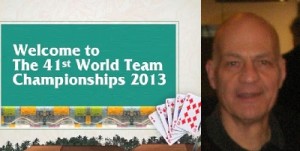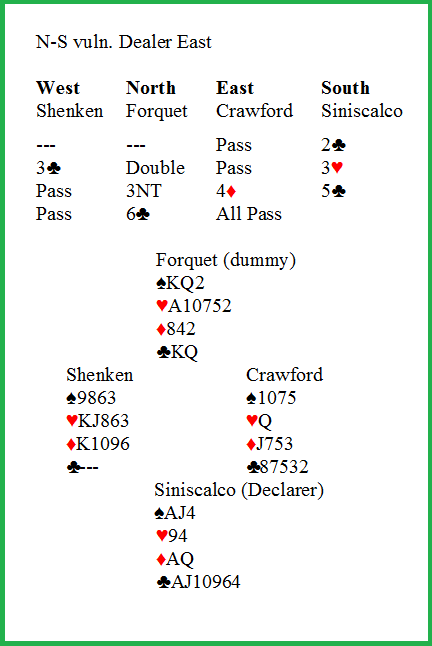 Bali 2013: The day before. The ingenuity of Guglielmo Siniscalco. According to the World Bridge Federation (WBF), the Bali edition would be the 41st of the World Open Championship, having the first been that of 1950 played in Bermuda, but this is not exact. The very first edition was played in Hungary in July 1937, won by Paul Stern’s Austria; in the same days was played the first Women World Championship, also won by Austria (Rixi Markus et al).
Bali 2013: The day before. The ingenuity of Guglielmo Siniscalco. According to the World Bridge Federation (WBF), the Bali edition would be the 41st of the World Open Championship, having the first been that of 1950 played in Bermuda, but this is not exact. The very first edition was played in Hungary in July 1937, won by Paul Stern’s Austria; in the same days was played the first Women World Championship, also won by Austria (Rixi Markus et al).
The women series called Venice Cup only started in 1974, whereas it was the 2001 when it was thought that the seniors needed of a private battlefield, and was invented the Ernesto D’Orsi Senior Bowl. Before, the seniors were considered the strongest; at 1964 Olympiad many wonder at the English Maurice Harrison Gray, then 65 yo: how could he be so strong? Easy – somebody explained – he’s so old that has already meet all the card combinations, and now he’s playing the second time and remembers them (reported by Carl’Alberto Perroux, Captain of Blue Team).
In the journey toward Bali someone stroke upon snags; an Israeli citizen dwelling in USA and playing for an USA team had had to wait in Singapore the visa for entering Indonesia. These waits sometimes happen in the history, even to kings: it was Henry IV, German of Salian dynasty, who in February 1077 had to kneel down three days under the snow before the Castle of Matilde di Canossa. At least it didn’t snow in Singapore.
Three teams, instead, couldn’t get to Indonesia; they are the Woman and Senior Israeli teams, withdrawn for analogue reasons, and Jamaica, which was impeded to go by one of the most stupid rule of WBF. These stories are told in “Bali 2013: The cases of Israel and Jamaica” (click here >>).
There is Bob Hamman in Senior Bowl; the strongest of living players (and probably the all time strongest player), failed to qualify for Bermuda Bowl. This person might be a winning factor not only for his team, but for both USA Open and Women teams as well, as adviser. His personality, his recognized authority can support and strengthen the strain of the captains.
In Venice Cup it is actually difficult to point the favourite out: the 2011’s title holders are French, but England beat them in 2012’s European Championship and in 2010’s World Mind Game (formerly Olympiad). Furthermore there is Indonesia, second placed in 2011, and the two USA Teams, Sonsini and Westheimer, and still have to be counted China, and Turkey, third force in Europe. This Venice Cup seems to be the strongest ever played, and this makes more and more grievous the absences of Israel and Jamaica.
The ingenuity of Guglielmo Siniscalco. Italy won the 1951 European championship, therefore it was our right to challenge the USA, title holder. The Americans who come to Naples were Howard Shenken, John Crawford, B. Jay Becker, Samuel Stayman, George Rapee, and Julius Rosenblum. The Italians were Eugenio Chiaradia, Augusto Ricci, Pietro Forquet, Guglielmo Siniscalco, Paolo Baroni, and Mario Franco. One deal was the following:

Shenken led spade; Siniscalco cleared the black suits, stripping Shenken to ♥KJ and ♦K10, then played heart ace and heart, endplaying him and making. At the other table Stayman and Rapee stopped in 3NT. This hand is reported by Henry Francis and Brian Senior in their fine book “The Bermuda Bowl best deals” (1999 Five Ace Books, England). The authors admit that the Italians’ auction wasn’t clear; we are trying to explain it now.
The 2♣ opening bid was natural in the range 11-16 (the strong opening was 1♣); Forquet’s double showed support, but there were problems. Generally, every NT call in Neapolitan Club, the system they were playing, needs the stopper in unnamed suits; besides, when the auction gets the three level in minor, new suits are stopper showing (or reverse). Now: the contract belongs to the opening line, it is clear, but was the Forquet’s double forcing to game, (as it was), or only inviting, as 2♣-3♣ in uncontested auction? And having Shenken showed three suits, and having the chance to pass, was the normal stopper bidding up the line still on? I have asked Guglielmo Siniscalco himself.
– True to tell – he replied – I don’t remember that hand. But we hadn’t agreements in such a situation, and I think that 3♥ here should be asking bid. But we lost: the Americans were great, they outclassed us.
– Yes, they won. But after…
– After we studied all the hands of that match, under the guide of Chiaradia, the Professor…
– Mr Siniscalco, why did you call “Professor” Eugenio Chiaradia?
– Because he was professor of philosophy in grammar school. Chiaradia analyzed these hands, and many other, finding and correcting the system mistakes, and showing us the personal ones. Seven years later we again won the European Championship and went to New York…–
…Where it began the Italian Legend. Siniscalco played in New York 1957; in Como 1958, and again in New York 1959, the first three Italian victories. After he had to withdraw because job commitments (he’s Civil Engineer); he moved from Naples to Bari, losing touch with his team-mates.
Grazie, Guglielmo.
***
Paolo Enrico Garrisi